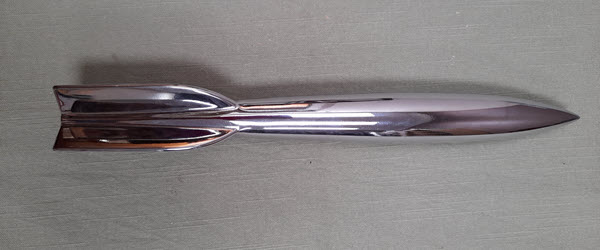The Hugo Award trophies, which provide recognition and incentives by the way of awards to demonstrate excellence in the field of science fiction and fantasy, vary from year to year, but all (save 1958’s awards) feature one prominent element: the finned Hugo rocket which stands atop the trophy.
The earliest Hugo Award trophy used a rocket designed by Jack McKnight and Ben Jason based upon the hood ornament from a 1950s American automobile; however, the shape of the rocket changed over the years as individual committees reinterpreted the design. The current design of the trophy rocket, which is now considered definitive, has been the same since Peter Weston’s refinement of the design debuted in 1984. Since then, every Hugo Award trophy rocket (except those used in 1991) has been literally cast from the same mold by Ashwater Foundry in England.
Each Worldcon Committee designs a base for the trophy. Some have been fairly plain; others have moved toward the fanciful and whimsical. The 1992 Hugo Award, presented by MagiCon, included pieces of an actual gantry from NASA’s Kennedy Space Center, while the 1994 Hugo Award, presented by ConAdian, contained pieces of “space metal” — pieces of Canadian sounding rockets that had actually been in space.
A collection of Hugo Award trophy photographs can be viewed through the links below. The photographs were primarily taken by Michael Benveniste and Sheila Perry.
- Making Hugos
- Hugo Award Specifications
- Caring for the Trophy
- 2023 Hugo Award Trophy
- 2022 Hugo Award Trophy
- 2021 Hugo Award Trophy
- 2020 Hugo Award Trophy
- 2019 Hugo Award Trophy
- 2018 Hugo Award Trophy
- 2017 Hugo Award Trophy
- 2016 Hugo Award Trophy
- 2015 Hugo Award Trophy
- 2014 Hugo Award Trophy
- 2013 Hugo Award Trophy
- 2012 Hugo Award Trophy
- 2011 Hugo Award Trophy
- 2010 Hugo Award Trophy
- 2009 Hugo Award Trophy
- 2008 Hugo Award Trophy
- 2007 Hugo Award Trophy
- 2006 Hugo Award Trophy
- 2005 Hugo Award Trophy
- 2004 Hugo Award Trophy
- 2003 Hugo Award Trophy
- 2002 Hugo Award Trophy
- 2001 Hugo Award Trophy
- 2000 Hugo Award Trophy
- 1999 Hugo Award Trophy
- 1998 Hugo Award Trophy
- 1997 Hugo Award Trophy
- 1996 Hugo Award Trophy
- 1995 Hugo Award Trophy
- 1994 Hugo Award Trophy
- 1993 Hugo Award Trophy
- 1992 Hugo Award Trophy
- 1991 Hugo Award Trophy
- 1990 Hugo Award Trophy
- 1989 Hugo Award Trophy
- 1988 Hugo Award Trophy
- 1987 Hugo Award Trophy
- 1986 Hugo Award Trophy
- 1985 Hugo Award Trophy
- 1984 Hugo Award Trophy
- 1983 Hugo Award Trophy
- 1982 Hugo Award Trophy
- 1981 Hugo Award Trophy
- 1980 Hugo Award Trophy
- 1979 Hugo Award Trophy
- 1978 Hugo Award Trophy
- 1977 Hugo Award Trophy
- 1976 Hugo Award Trophy
- 1975 Hugo Award Trophy
- 1974 Hugo Award Trophy
- 1973 Hugo Award Trophy
- 1972 Hugo Award Trophy
- 1971 Hugo Award Trophy
- 1970 Hugo Award Trophy
- 1969 Hugo Award Trophy
- 1968 Hugo Award Trophy
- 1967 Hugo Award Trophy
- 1966 Hugo Award Trophy
- 1965 Hugo Award Trophy
- 1964 Hugo Award Trophy
- 1963 Hugo Award Trophy
- 1962 Hugo Award Trophy
- 1961 Hugo Award Trophy
- 1960 Hugo Award Trophy
- 1959 Hugo Award Trophy
- 1958 Hugo Award Trophy
- 1957 Hugo Award Trophy
- 1956 Hugo Award Trophy
- 1955 Hugo Award Trophy
- 1954 Retro Hugo Award Trophy
- 1953 Hugo Award Trophy
- 1951 Retro Hugo Award Trophy
- 1946 Retro Hugo Award Trophy
- 1945 Retro Hugo Award Trophy
- 1944 Retro Hugo Award Trophy
- 1943 Retro Hugo Award Trophy
- 1941 Retro Hugo Award Trophy
- 1939 Retro Hugo Award Trophy


